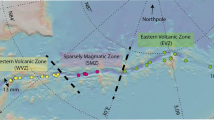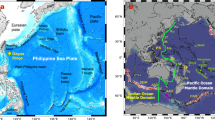Abstract
Basaltic lavas which have erupted along the great oceanic ridge system are characterized by their overall chemical and isotopic homogeneity. Nevertheless, they show evidence for variability in the chemical and isotopic composition of the ocean ridge basalt (ORB) source whose scale and distribution remain uncertain. Isotopic compositions of Sr, Nd, Pb and Hf and ratios of some highly incompatible elements have been used as tracers of ORB source compositions, usually permitting source characteristics to be distinguished from petrogenetic effects. The Mid-Atlantic Ridge (MAR), in particular, shows correlations in the isotopic compositions of several elements, between isotopic compositions and topography and between these parameters and incompatible element concentrations and ratios1–3. We report here isotopic measurements for basalts, dredged between approximately 30 and 34° S on the East Pacific Rise and adjacent Maddingly Rise, which show highly uniform Sr and Nd isotopic compositions, possibly resulting, in part, from mixing associated with a high rate of magma generation and rapid spreading (∼170 mm yr−1). However, a ridge segment of comparable length between 18 and 22° S and with only a slightly lower spreading rate shows much greater isotopic variability. Hence we are apparently sampling small but detectable regional differences in mantle composition. The isotopic homogeneity among the basalts from 30 to 34° S implies that any heterogeneity in the underlying upper mantle is uniformly distributed on a scale much smaller than the volume sampled in individual magma batches, and is thus averaged out in the resulting lavas.
This is a preview of subscription content, access via your institution
Access options
Subscribe to this journal
Receive 51 print issues and online access
$199.00 per year
only $3.90 per issue
Buy this article
- Purchase on Springer Link
- Instant access to full article PDF
Prices may be subject to local taxes which are calculated during checkout
Similar content being viewed by others
References
Cohen, R. S. & O'Nions, R. K. J. Petrol. 23, 299–324 (1982).
Dupré, B. & Allègre, C. J. Nature 286, 17–21 (1980).
White, W. M. & Schilling, J.-G. Geochim. cosmochim. Acta 42, 1501–1516 (1978).
Schilling, J.-G. Nature 242, 565–571 (1973).
Carlson, R. W., Macdougall, J. D. & Lugmair, G. W. Geophys. Res. Lett. 5, 229–232 (1978).
Allègre, C. J., Dupré, B. & Hamelin, B., Trans. Am. geophys. Un. 64, 324 (1983).
Hamelin, B., Dupré, B. & Allègre, C. J. Earth planet. Sci. Lett. 67, 340–350 (1984).
Batiza, R. Nature 309, 440–441 (1984).
Herron, E. M. Nature phys. Sci. 240, 35–37 (1972).
Herron, E. M. Bull. geol. Soc. Am. 83, 1671–1692 (1972).
Minster, J. B. & Jordan, T. H. J. geophys. Res. 83, 5331–5354 (1978).
Craig, H., Kim, K.-R. & Francheteau, J. Trans. Am. geophys. Un. 64, 856 (1983).
Mammerickx, J. & Smith, S. M. Geol. Soc. Am. Map Ser. MC- 26 (1978).
Author information
Authors and Affiliations
Rights and permissions
About this article
Cite this article
Macdougall, J., Lugmair, G. Extreme isotopic homogeneity among basalts from the southern East Pacific Rise: mantle or mixing effect?. Nature 313, 209–211 (1985). https://doi.org/10.1038/313209a0
Received:
Accepted:
Issue Date:
DOI: https://doi.org/10.1038/313209a0
This article is cited by
-
Enrichments of the mantle sources beneath the Southern Volcanic Zone (Andes) by fluids and melts derived from abraded upper continental crust
Contributions to Mineralogy and Petrology (2014)
-
Large-scale chemical and thermal division of the Pacific mantle
Nature (1999)
-
Chemical and isotopic variations along the superfast spreading East Pacific Rise from 6 to 30�S
Contributions to Mineralogy and Petrology (1994)
-
Global correlations of mid-ocean-ridge basalt chemistry with seismic tomographic images
Nature (1993)
-
Sr, Nd and Pb isotopic compositions of calc-alkaline and peralkaline silicic volcanics from the D'Entrecasteaux Islands, Papua New Guinea, and their tectonic significance
Mineralogy and Petrology (1992)
Comments
By submitting a comment you agree to abide by our Terms and Community Guidelines. If you find something abusive or that does not comply with our terms or guidelines please flag it as inappropriate.



